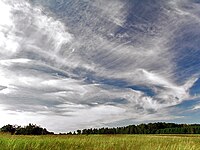
Photo from wikipedia
Abstract. The physical properties and radiative role of ice clouds remain one of the uncertainties in the Earth–atmosphere system. In this study, we present a detailed analysis of ice cloud… Click to show full abstract
Abstract. The physical properties and radiative role of ice clouds remain one of the uncertainties in the Earth–atmosphere system. In this study, we present a detailed analysis of ice cloud properties based on 4 years of surface millimeter-wavelength radar measurements in Beijing, China, where the summer monsoon from the ocean and the winter monsoon from the continent prevail alternately, resulting in various ice clouds. More than 6300 ice cloud clusters were studied to quantify the properties of ice clouds, such as the height, optical depth and horizontal extent, which can serve as a reference for parameterization and characterization in global climate models. In addition, comparison between ice cloud clusters formed under the summer monsoon and the winter monsoon indicates the different formation and evolution mechanisms of cirrus clouds. Statistically, temperatures of more than 95 % of ice radar bins are below − 15 ∘ C and more than 80 % of ice clouds are above 7 km. The dependence of the radar reflectivity of ice particles on height and temperature was also observed in this study, indicating that the reflectivity of ice bins increases (decreases) as the temperature (height) increases. In addition, it is found that there is a strong linear relationship between the mean reflectivity and the ice cloud depth. Due to various synoptic circumstances, the ice clouds in summer are warmer, higher and thicker, with larger reflectivity than that in winter; in particular, the mean cloud-top height of ice clouds in summer is 2.2 km higher than that in winter. Our analysis indicates that in spring, in situ-origin cirrus clouds are more common than liquid-origin cirrus clouds, while in summer liquid-origin cirrus clouds are more frequent; in autumn and winter, most cirrus clouds are of in situ origin.
Journal Title: Atmospheric Chemistry and Physics
Year Published: 2020
Link to full text (if available)
Share on Social Media: Sign Up to like & get
recommendations!